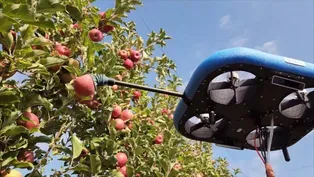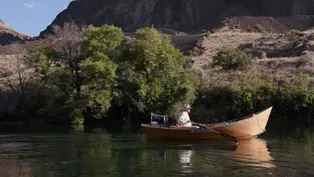Oregon Field Guide
Horse Trainer
Clip: Season 34 Episode 9 | 5m 24sVideo has Closed Captions
Clint Surplus trains horses in a style dating back more than 500 years.
Horse trainer Clint Surplus carries on the centuries-old tradition of vaquero bridle horses.
Problems with Closed Captions? Closed Captioning Feedback
Problems with Closed Captions? Closed Captioning Feedback
Oregon Field Guide is a local public television program presented by OPB
Oregon Field Guide
Horse Trainer
Clip: Season 34 Episode 9 | 5m 24sVideo has Closed Captions
Horse trainer Clint Surplus carries on the centuries-old tradition of vaquero bridle horses.
Problems with Closed Captions? Closed Captioning Feedback
How to Watch Oregon Field Guide
Oregon Field Guide is available to stream on pbs.org and the free PBS App, available on iPhone, Apple TV, Android TV, Android smartphones, Amazon Fire TV, Amazon Fire Tablet, Roku, Samsung Smart TV, and Vizio.
Providing Support for PBS.org
Learn Moreabout PBS online sponsorship- Personally, I have no idea how many horses I've ridden in my life or worked with in some capacity.
As far as starting out, I hear tell that my riding days began first trimester.
(horse hooves pattering) My mom rode while she was pregnant with me and my two sisters.
- They grew up on horses.
They all love them.
At a young age, when you do that, you just have a innate feeling of what the horse is gonna do and how to ride, and it just comes with a territory if you grow up doing it.
- [Narrator] Clint Surplus's is life work has changed a lot of horses.
In the process, horses have changed him.
- I started my first colt when I was, I wanna say, about 11, then I rode my first colt for hire, must've been when I was 12 or 13.
But until you've ridden a horse that has a more sophisticated training level, you don't know what that feels like.
(horse hooves pattering) - [Narrator] When Clint was a young man he worked for a large ranch in Southeast Oregon.
(cow moos) There he discovered horses trained to a high degree for the roping and riding of ranch work.
Known as bridle horses, trained in the vaquero tradition.
(mellow instrumental music) Vaqueros were expert riders from the era of the Spanish haciendas.
Their name came from the word vaca, Spanish for cow.
(mellow instrumental music continues) They were the original cowboys of the West.
- The traditions go back centuries, and yet the tools have not been improved upon.
- [Narrator] The ornate spade bit is the symbol of the bridle horse.
This is what the horses are ultimately being trained to use.
The large flat part of the bit is shaped like a shovel or a spade.
In the wrong hands, it can apply harsh pressure to the horse's mouth, but the vaquero tradition is not about using force on a horse's mouth to make it move, rather to form a connection with the horse's mind.
This subtle melding of minds involves no bit at all, and begins in the round pen.
(horse hooves pattering) - The round pen helps you to connect with the horse's mind.
We're not forcing the horse to stop or turn or go fast.
We're communicating in a very subtle and nearly imperceptible way to the horse.
Being a prey animal and a herd animal gives them a very complex set of instincts, and we have to learn how to work with them within their instincts.
(hand scratching) (hand patting) I want to build the kind of bond between me and my horse where my horse doesn't want to leave me.
Drawing the horse in and letting them be with us and be comfortable develops trust from the horse.
(gate creaks) (cattle moo) Ride right in tight behind me.
- [Narrator] The vaquero skills came from cattle work.
Clint's daughter, Sadie, and son, Kasen, help move cattle to new pasture.
- Sadie, you stop about right there at that dry spot.
Kasen, you start riding along the fence there, trying to peel 'em off the fence.
When I was about to become a father, I was confident that my experience with horses was going to help me better raise my kids.
Watch that one in the back, Sadie.
But what I didn't anticipate was that being a father helped me become a better horseman.
(cattle mooing) I softened.
And just let 'em file through.
And that softness goes farther with a horse than harshness.
(Clint's lips squeak) When you're riding a horse that you're just really in sync with, it's harmony.
And that's the essence of a vaquero-style bridle horse.
My horses don't have the sting they once had.
They don't have the snappiness that they once had, but they have a calmness and a confidence that they didn't once have.
(horse hooves clopping) And there's a beauty in that.
(horse hooves clopping) (no audio) (no audio) - Great people just doing their thing in their own Northwesty way.
We love bringing you stories like this.
Support what you love, opb.org/video.
(upbeat music)
Video has Closed Captions
Meet the brave man who maintains the outhouses along the Deschutes River. (9m 40s)
Providing Support for PBS.org
Learn Moreabout PBS online sponsorshipSupport for PBS provided by:
Oregon Field Guide is a local public television program presented by OPB













